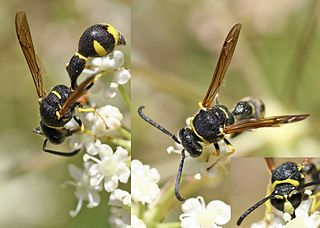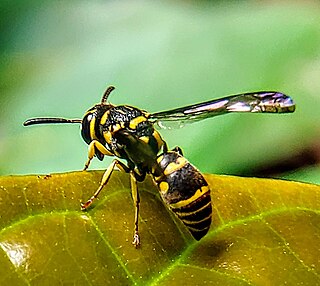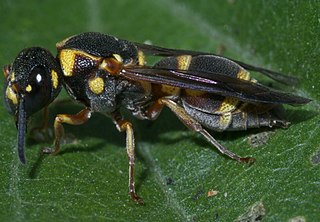Related Research Articles

Eumenes is a genus of wasps in the subfamily Eumeninae. It is a large and widespread genus, with over 100 species and subspecies occurring worldwide. The genus was first proposed by Pierre André Latreille in 1802, with the type species later designated by Latreille in 1810. All species make jug-like nests out of mud, usually attached to twigs. The larvae are fed with caterpillars.

Ancistrocerus is a widely distributed genus of potter wasps present in many biogeographical regions of the world. They are nonpetiolate eumenine wasps with a transverse ridge at the bending summit of the first metasomal tergum and with a low and opaque propodeal lamella completely fused to the submarginal carina.

Delta is an Old World genus of potter wasps with species predominantly distributed through tropical Africa and Asia. Some species are present in the Palearctic region, and a few have been introduced in the Nearctic and Neotropical regions. The members of this genus have a long metasomal petiole, like members of the genera Eumenes and Zeta.
Chlorodynerus is an old world genus of potter wasps. The following species are included in this genus:
Cyrtolabulus is an African, Indomalayan and Palearctic genus of potter wasps. It contains the following species:

Stenodyneriellus is an Australasian and Indomalayan genus of potter wasps.

Subancistrocerus is an Australian, Indomalayan, African and Palearctic genus of potter wasps. Males of this genus used to have an enlarged antennal tip.

Stenodynerus is a rather large genus of potter wasps whose distribution spans the Nearctic, Palearctic, Oriental and Neotropical regions. Most of its species lack a transverse carina on the first metasomal tergum. A pair of medial pits on the anterior face of the pronotum and the expansion of the tegulae put this genus close to genera as Parancistrocerus, Hypancistrocerus and Eustenancistrocerus.
Knemodynerus is a genus of potter wasps distributed through the Palearctic, Afrotropical, Indomalayan and Australasian regions. The species currently classified in the genus are:
Lissodynerus is an Indomalayan and Australasian genus of potter wasps. The following species are classified under Lissodynerus:

Stroudia is an Afrotropical genus of potter wasps.
Eumenidiopsis is an afrotropical genus of Afrotropical potter wasps with eight known species, which are set out below:
Eustenancistrocerus is an Afrotropical, Palearctic and Oriental genus of potter wasps. The species in this genus include:
Micreumenes is an Afrotropical genus of potter wasps with 30 described species.
Paravespa is an Afrotropical and Palearctic genus of potter wasps.

Proepipona is an Afrotropical genus of potter wasps.
Pseudepipona is a genus of potter wasps found in the Palearctic, Nearctic, Afrotropical and Australian regions.Andrey sus

Pseudonortonia is a fairly large genus of potter wasps with a rich Afrotropical fauna, as well as with several species which occur throughout the Palearctic and Indomalayan regions.
Rhynchalastor is a moderately large afrotropical genus of potter wasps with 25 species currently known. Some authorities expand the genus to include species otherwise classified under related genera such as Stenodynerus
Afreumenes violaceus is a species of wasp in the family Vespidae. It was described by Giordani Soika in 1941.
References
- ↑ "Polistepipona Giordani Soika, 1989". www.gbif.org. Retrieved 2025-01-23.